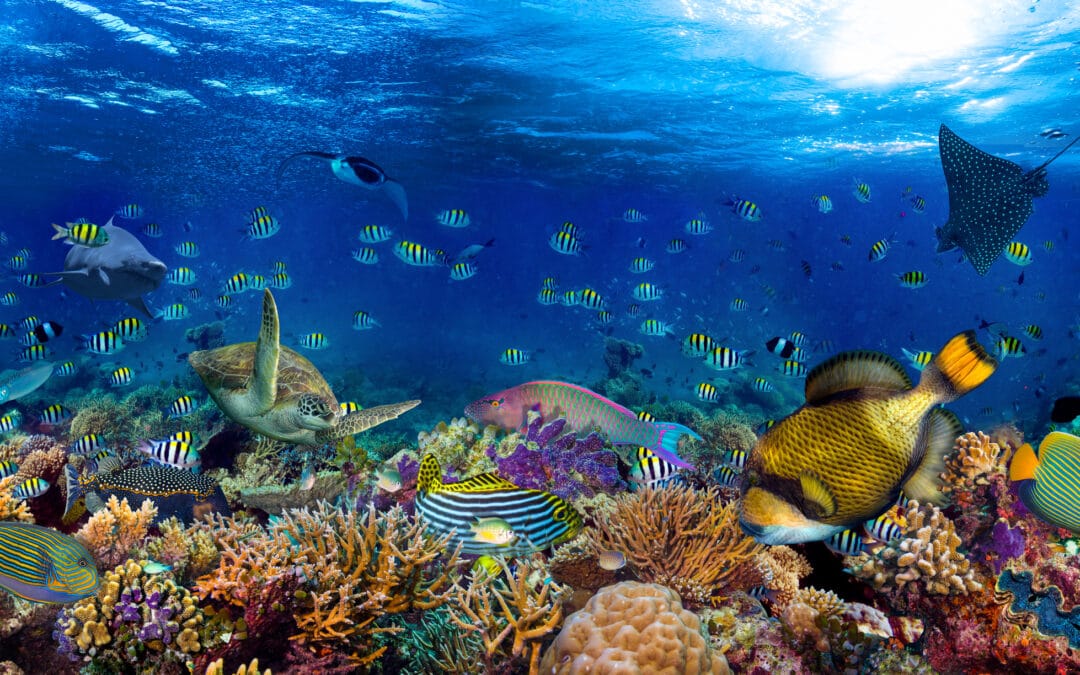Seafood is an excellent source of essential nutrients, including lean protein, omega-3 fats, iodine, and selenium. However, concerns about seafood toxins have prompted health practitioners to advise caution when selecting fish and shellfish. Some of the toxins found in seafood include:
- polychlorinated biphenyls (PCBs)
- per- and poly-fluoroalkyl substances (PFAS or “forever chemicals”)
- Mercury
- DDT (dichlorodiphenyltrichloroethane)
These toxins, which are human carcinogens, can accumulate and persist in aquatic environments due to industrial pollution and can pose serious health risks when consumed.
Mercury in Seafood
Mercury is a neurotoxin (destructive to nerve tissue) that concentrates in larger, longer-lived predatory fish such as sharks, swordfish, king mackerel, and some types of tuna.
A 2023 study1 found that frequent consumption of high-mercury fish was associated with elevated inflammation and oxidative stress markers in adults. This suggests a potential link to chronic disease risk, including heart disease and cognitive decline.
Prenatal mercury exposure can adversely affect fetal brain and nervous system development and impact a child’s memory, cognitive thinking, attention, language, and fine motor and visual skills. A review of 91 studies2 that examined the relationship between mercury and autism spectrum disorder (ASD) suggests that mercury exposure is not only a risk factor, but may contribute to the health condition. Remember, mercury toxicity can accumulate over a lifetime, so other mercury exposure sources must be considered besides seafood, such as childhood vaccines, silver fillings (in mothers), fever thermometers, and specific types of novelty jewelry.
PCBs and PFAS
PCBs and PFAS have been detected in both freshwater and marine seafood. Although PCBs are banned, they persist in the environment. PFAS, used in non-stick coatings, firefighting foams, and water-resistant products, are now recognized as endocrine disruptors with links to immune dysfunction and cancer. A recent analysis3 of U.S. commercial seafood showed PFAS contamination in multiple species, including cod and shrimp, raising concerns about the cumulative effects of dietary exposure.
DDT
Dichlorodiphenyltrichloroethane (DDT) is a persistent organochlorine pesticide. Despite being banned or restricted in many countries, it poses environmental and health risks due to its long half-life and bioaccumulative properties. This toxin enters aquatic ecosystems through agricultural runoff and atmospheric deposition, accumulating in the fatty tissues of marine organisms. Chronic exposure to DDT through seafood consumption can cause endocrine disruption, reproductive toxicity, and an increased risk of certain cancers in humans.
Choose Low-Toxin Seafood
To reduce seafood toxins while enjoying the nutritional benefits of seafood, choose smaller, short-lived species that are lower on the food chain. Safer choices4,5 include:
- Wild-caught sockeye salmon from Chile or Alaska
- Shrimp (wild-caught)
- Chunk Light Skipjack Tuna. Skipjack is a fast-swimming fish and the smallest of all tuna species. It has the least amount of mercury and toxins.
- Yellowfin tuna from the Northern and Southern Pacific, South Atlantic, and Indian Oceans. Wild Planet® offers sustainably caught yellowfin from these waters. Safe Catch® implemented tracing for its tuna taken from the Western Central Pacific. Also, pole- and line-caught yellowfin from the Pacific Northwest and the Maldives are good choices.
- Pacific cod, pollock, haddock, and sole from Alaska
- Select Pacific and Alaskan flounder (called Hiromi when ordering sushi) instead of Northeastern Atlantic.
- Alaskan king crab, stone, blue, Dungeness, and southern tanner crabs (called kani when ordering sushi).
- West Coast lobster, wild-caught Abalone, octopus, squid, and sea urchin are safe to consume.
- Pacific Halibut has low levels of PCBs (limit to once a month).
- Tilapia is low in mercury and safe, although it usually gets a bad rap.
- Trout from high mountain lakes, rivers, and streams (before they flow to the lowlands).
- Pole-caught Mahi Mahi (or caught by trolling)
- Sardines, mussels, oysters, anchovies, herring, and Atlantic Mackerel
Seafood to Avoid
These have the highest chemical concentrations and are not safe.
- European farmed or wild salmon (Scottish, Norwegian, or Faroe Islands) have high levels of PCBs
- Yellowfin tuna from the northeast Atlantic, the Gulf of America, and industrialized shores contain high mercury and DDT
- Canned white albacore tuna (three times more mercury than chunk light)
- Wicked Tuna (bluefin from the northeast Atlantic or Mediterranean) has the highest levels of PCBs, DDT, and mercury (sushi lovers beware)
- King and Spanish Mackerel
- Sturgeon from the inland waters of the U.S.
- Marlin
- Swordfish
- Shark
- Tilefish
- Orange roughy
- Gefilte fish, catfish, and carp
- Freshwater striped, smallmouth, and largemouth bass, perch, sunfish, and lake trout
- Canned oysters, mussels, and clam products from China
As a general guideline, select wild-caught over farm-raised seafood, and choose smaller, short-lived species. Mindful seafood choices protect health and contribute to sustainable fishing and cleaner ecosystems. Stay informed and choose wisely to enjoy the nutritional benefits of seafood without toxic exposure.
References
- Sheehan MC, Burke TA, Fox MA. Association between mercury exposure from seafood and markers of oxidative stress: A population-based study. Environ Health Perspect. 2023;131(2):027002.
- Kern JK, Geier DA, Sykes LK, Haley BE, Geier MR. The relationship between mercury and autism: A comprehensive review and discussion. J Trace Elem Med Biol. 2016 Sep;37:8-24. doi: 10.1016/j.jtemb.2016.06.002. Epub 2016 Jun 2. PMID: 27473827.
- Barbo N, Sunderland EM, Hu XC, et al. PFAS in seafood: Potential dietary exposure and implications for public health. Environ Sci Technol. 2022;56(18):12345-12354.
- Environmental Working Group’s Good Seafood Guide.
- Well-Being Journal article “Safer Seafood for Stronger Healthier Families,” Vol 34, No. 1, January/February 2025.

